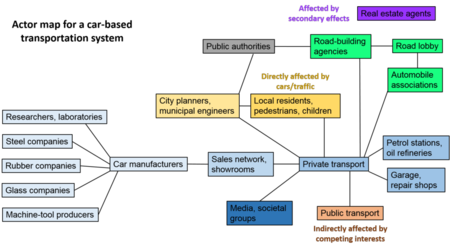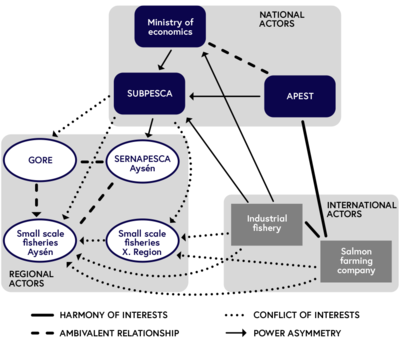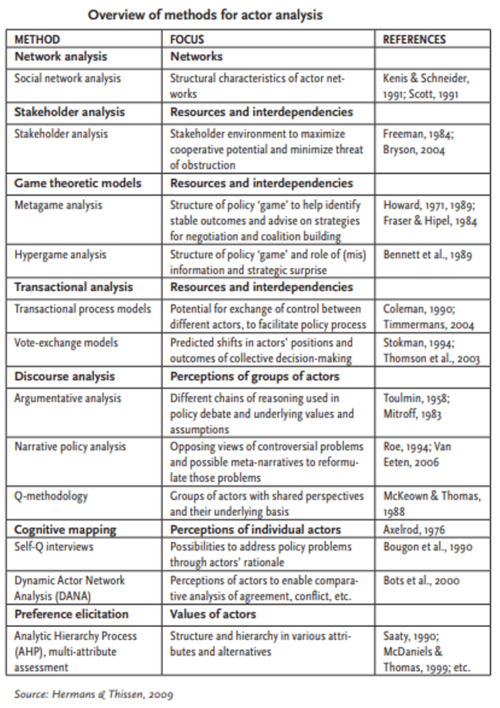Actor Analysis
Definition of Actor Analysis
What is Actor Analysis? Actor Analysis examines how people and groups react and work with one another. Actor analysis is an analysis of all relevant actors. Relevant actors are:
- Actors that have an interest in the decision making;
- Actors that can hinder the decision making;
- Actors that can enrich the decision making;
- Actors that has to be involved on moral arguments.[1]
In other words: actors are those parties that have a certain interest in the system and/or that have some ability to influence that system, either directly or indirectly. Note that we use the term ‘actor’, and not ‘stakeholder’. In practice, the terms are often interchanged. However, sometimes the term stakeholder is used to refer to those groups that have an interest, or stake, in decision-making processes, but that have relatively few means to influence decision-making or the system. Such stakeholders typically include interest groups or pressure groups and, in some cases, the public at large or a specific part of the public such as poor households, people of a certain age-group or the beneficiaries of a certain welfare scheme.

source: University of Twente
Overview on Potentially Relevant Actors[2]
Below is a sequence of steps providing an overview on potentially relevant actors for a TDR project. The sequence is based on Cash et al.[3]; as shortened and adapted by Tobias Buser.
- Step 1: Start with the (broad) focus or overarching goal of the project and identify the relevant geographical scales (ie local, regional, and global).
- Step 2: Find actors in the system of interest. Answer the questions below with the aim of generating a (usually long) list of all potentially relevant actors. Regarding the project’s topic and overarching goals:
- Who has decision power?
- Who is able to act and who needs to act?
- Who can elaborate/change regulations and policies?
- Who do you expect to have important knowledge and expertise?
- Who should consider the results of the project?
- Who should know about the project?
- Who is affected by the project (intentionally and unintentionally)?
- Who can affect the project?
- Step 3: Differentiate and categorise stakeholders. Possible categories:
- Roles of the stakeholders: What are the roles and main tasks of a specific actor or actor group regarding the field of interest?
- Scale: What is the scale of influence for specific actors (local, regional, national, international, or global)?
- Interest in the project: What are the main interests a specific actor has regarding the main goals of the project?
Note: Cross-tables with the actors on one axis and the categories on the other axis are a convenient way for an overview.
- Step 4: Want to keep Power and relations. Analyse potential stakeholders’ interest and power regarding the project.
(1) Power/interest grid: The power/interest grid helps to classify actors in a way that informs who to involve. To conduct a power/interest grid, you need a certain degree of knowledge on the actor system in the field of interest. As your knowledge on the actor system increases through face to face exchange (eg interviews), surveys, and desktop analysis, the power/interest grid becomes more reliable. It is thus advisable to reconsider it from time to time. Classify the actors based on your current knowledge into one of the four quadrants – note that power can be constituted by several factors, eg power to take decisions, economic power, social capital, knowledge, and others.
The position in the quadrants indicates the degree of involvement:

Power/interest matrix. (Based on Reed et al., 2009)
Low power/low interest: These actors are currently of little importance for the project. However, keep in mind that interest and/or power of an actor can change over time. Low power/high interest: While these actors have little power, they may be important stakeholders for your project. Often they are directly affected by issues the project tackles, eg local farmers or migrants. Note that this is a big difference to how the power/interest grid is interpreted in corporate contexts. High power/low interest: This group is the most difficult to deal with. These are often ‘gate-keepers’ that can be decisive about a project’s success, but are usually very difficult to get in collaboration with. Sometimes, awareness-raising can make them more interested. Otherwise, strategies are needed that require little engagement from these actors, but keep them satisfied. High power/high interest: These are the actors to clearly engage with in the project.
(2) Mapping of stakeholder relations: Especially in complex, contested systems, it is also important to have an idea on the relationships between the different actors. Mapping actor relations can already be a result on its own, but mainly it helps to design co-production processes in a more effective way. For example: In actor systems showing many conflictive relationships (as in the example shown below), it is recommended to first work with several sub-groups.

Example of a stakeholder mapping: small scale fisheries in southern Chile. (Based on Schneider & Buser, 2003)
Actor Identification Techniques
There are different methods that complement each other and that help analysts make a first selection of actors that are may be involved. However, the different actor identification approaches discussed by Mitroff offer a useful starting point(Mitroff, 1983) and can be complemented by identification techniques discussed elsewhere. The resulting techniques are complementary, if partly overlapping, and their joint use is likely to result in a list that has less risk of omitting important actors. They can be used by the analyst, preferably in dialogue with the problem owner, and one or more key informants, persons knowledgeable about the policy field.
- The imperative approach identifies actors who feel strongly enough about a certain policy problem or issue to act on their feelings. More generally, one could ask ‘Who has an interest in or feel the consequences of the issues around which the problem revolves, or the solutions that are being considered?’
- The positional approach reviews the existing policy making structures to identify actors with a formal position in policy making. Studying the formal legislation, procedures, policy pieces, and so on, provides a first indication of the parties that are possibly involved.
- The reputational approach uses key informants related to the policy problem and asks them to identify important actors. The resulting list of actors may be further expanded by asking each of the actors on the list to nominate additional actors. The latter technique is known as ‘snowballing’ (Wasserman & Faust, 1994). A variation to this technique is for the analyst to ask for any of the seemingly important actors who have important relationships with that actor.
- The social participation approach identifies actors to the extent that they participate in activities related to a policy issue. For instance as part of committees, by attending meetings, or as part of platforms.
- The opinion leadership method identifies actors who tend to shape the opinions of other actors. For instance, the opinions of certain universities or research groups, certain international organizations or certain individuals may be highly influential.
- The demographic approach identifies actors by such characteristics as age, sex, occupation, religion, level of education, residence etc. This is relevant when policy problems and policy options have a different impact on different demographic groups.
- Finally, the problem diagram and the causal map offer important leads. Relevant actors can be identified by asking the question: ‘Who influences, directly or indirectly, relevant system factors?’ Attention needs to be given here to the actors and factors inside the system, as well as in the environment of the system.
Steps in Actor Analyses
The following are steps that need to be followed in general actor analyses. The core of the method described here is taken from the guidelines for stakeholder analysis that are available in various documents. However, whereas stakeholder analysis methods typically focus on the dimensions of power and interests of actors, the scan of the actor network must also cover the network structure and perceptions of actors. This results in a basic procedure for actor analysis that covers six steps: 1. formulation of a problem as a point of departure; 2. inventory of the actors involved; 3. exhibiting the formal chart: the formal tasks, authorities, and relations of actors and the current legislation; 4. determining the interests, objectives and problem perceptions of actors; 5. mapping out the interdependencies between actors by making inventories of resources and the subjective involvement of actors with the problem; 6. determining the consequences of these findings with regard to the problem formulation.
Methods for Actor Analysis
There are several methods available to support actor analysis. In practice, most use is made of approaches for stakeholder analysis, which are rooted in strategic management literature (see e.g. Mitroff, 1983; Freeman, 1984; Grimble & Chan, 1995; Bryson, 2004). The popularity of stakeholder analysis methods is explained by the fact that they are relatively easy to use and can be applied in a wide range of situations. Furthermore, these methods are flexible enough to cover a wide range of conceptual dimensions. These qualities also make stakeholder analysis methods very useful for an initial problem exploration. Hence, they provide the basis for the actor analysis approach described herein.
However, it should be kept in mind that in many cases it may be worthwhile to carry out an actor analysis that goes beyond an initial scan or exploration. In such cases, a more focused and detailed actor analysis method is required. In these cases, several methods are available depending on the concepts that are of most interest. These include for instance methods that focus specifically on the structure of social networks (Scott, 1991), methods that map actor perceptions (Bots et al., 2000) and methods that analyze conflicts between actors. An overview of different actor analysis methods for policy analysts is provided in the Table above. More background information on the methods in this overview and their use can be found in Hermans and Thissen (2009) and Hermans (2005).
Benefits and Limitations of Actor Analysis
Benefits
- Valuable method to ensure that all the relevant players in a system or associated with an issue have been considered in terms of their likely attitudes and responses to change
- Can be used by both individual analysts and teams
Limitations
- May be incomplete if not used with other methods or iterations do not go deep enough.
- Actor Analysis Produces a Snapshot Only: The findings of the actor analysis result in a snapshot. Actors’ problem perceptions change continually, as do their objectives, strategies and mutual relations. This continual dynamic causes strategic and institutional uncertainty. This uncertainty needs to be taken into account. The possibility to discount this uncertainty in the analysis itself is limited. That’s why it is important to be aware of the fact that the validity of the findings from an actor analysis is limited in time. The mostimportant remedy is to re-execute the analysis after a period of time.
- Trustworthy Sources of Information: Real world actor networks can be characterized as messy, dynamic and ill-defined systems. The task of an analyst is to provide some structure in this mess that allows him to extract some useful lessons for the problem formulation and interaction strategies of the problem owner. In this task, the analyst requires sound and trustworthy information on the characteristics and relations of the actors. Unfortunately, such information sources are not always easy to come by.
References
- ↑ Description of the Tool Manageing for Impact
- ↑ Steps Providing an Overview on Potentially Relevant Actors Tobias Buser
- ↑ Reed, M., Graves, A.R., Dandy, N., Posthumus, H., Klaus, H., Morris, J., Prell, C., Quinn, C., Stringer, L. (2009). Who’s in and why? A typology of stakeholder analysis methods for natural resource management. Journal of environmental management, 90(5), 1933-49.


